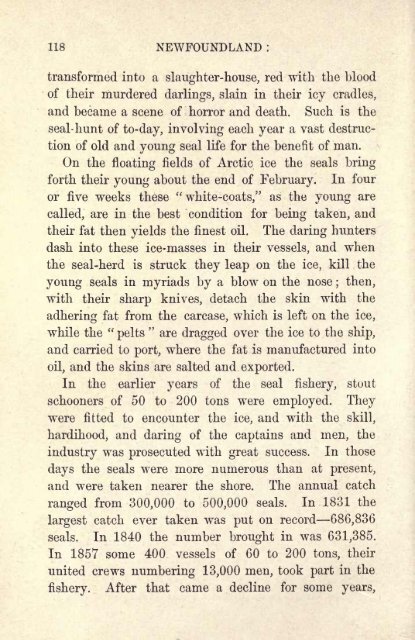Newfoundland in 1897 - Rumbolt
Newfoundland in 1897 - Rumbolt
Newfoundland in 1897 - Rumbolt
You also want an ePaper? Increase the reach of your titles
YUMPU automatically turns print PDFs into web optimized ePapers that Google loves.
118 NEWFOUNDLAND :<br />
transformed <strong>in</strong>to a slaughter-house, red with the blood<br />
of their murdered darl<strong>in</strong>gs, sla<strong>in</strong> <strong>in</strong> their icy cradles,<br />
and became a scene of horror and death. Such is the<br />
seal- hunt of to-day, <strong>in</strong>volv<strong>in</strong>g each year a vast destruc-<br />
tion of old and young seal life for the benefit of man.<br />
On the float<strong>in</strong>g fields of Arctic ice the seals br<strong>in</strong>g<br />
forth their young about the end of February. In four<br />
or five weeks these "white-coats," as the young are<br />
called, are <strong>in</strong> the best condition for be<strong>in</strong>g taken, and<br />
their fat then yields the f<strong>in</strong>est oil. The dar<strong>in</strong>g hunters<br />
dash <strong>in</strong>to these ice-masses <strong>in</strong> their vessels, and when<br />
the seal-herd is struck they leap on the ice,<br />
kill the<br />
young seals <strong>in</strong> myriads by a blow on the nose ; then,<br />
with their sharp knives, detach the sk<strong>in</strong> with the<br />
adher<strong>in</strong>g fat from the carcase, which is left on the ice,<br />
while the " "<br />
pelts are dragged over the ice to the ship,<br />
and carried to port, where the fat is manufactured <strong>in</strong>to<br />
oil, and the sk<strong>in</strong>s are salted and exported.<br />
In the earlier years of the seal fishery, stout<br />
schooners of 50 to 200 tons were employed. They<br />
were fitted to encounter the ice, and with the skill,<br />
hardihood, and dar<strong>in</strong>g of the capta<strong>in</strong>s and men, the<br />
<strong>in</strong>dustry was prosecuted with great<br />
success. In those<br />
days the seals were more numerous than at present,<br />
and were taken nearer the shore. The annual catch<br />
ranged from 300,000 to 500,000<br />
seals. In 1831 the<br />
largest catch ever taken was put on record 686,836<br />
seals. In 1840 the number brought <strong>in</strong> was 631,385.<br />
In 1857 some 400 vessels of 60 to 200 tons, their<br />
united crews number<strong>in</strong>g 13,000 men, took part <strong>in</strong> the<br />
fishery. After that came a decl<strong>in</strong>e for some years,






